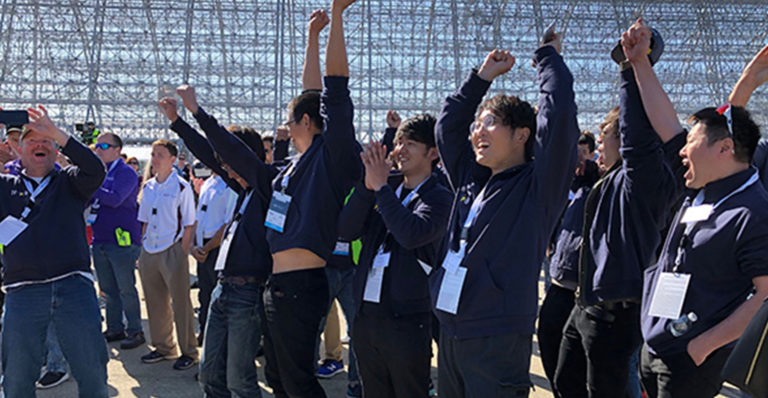Vladimir Spinko isn’t the first to dream of a world where the speeder from the famous forest chase scene in Star Wars: Return of the Jedi truly exists—but he is among the first to actually build something resembling it. One of five winners of Phase II of the GoFly Prize, Spinko and his nine fellow members of team Aeroxo have successfully built a working prototype of the ERA Aviabike (which Spinko describes as “a flying motorbike”) and are working towards making a full-size device ready for the GoFly Prize Final Fly-Off, set for early 2020.
Back in 2007, the Moscow Institute of Physics and Technology graduate was working at investment firm I2BF Global Ventures as an analyst, handling deal sourcing, assessing technology and performing due diligence. But he wanted to do more than help fund new technology. He wanted to create it.
So, armed with colleague Eldar Razroev’s idea for the first-ever small commercial tiltrotor UAV (unmanned aerial vehicle) and an early investment from I2BF’s Ilya Golubovich, Spinko and his tight-knit team co-founded Aeroxo in September 2014.
Drone Meets Driver
Spinko and Aeroxo’s other founding members Golubovich and Razroev got to work immediately, assembling a team of seasoned experts, eager second-year students and other contributors from across Moscow and Kazan who were capable of actualizing the tiltrotor UAV Spinko envisioned. But for about two years, the team struggled to get the device off the ground—literally. It wasn’t until the fall of 2016 that Aeroxo’s Moscow-based engineers executed their first successful test flight, lifting into the air a drone that looked very different from the team’s original design.
“That’s when we learned an important lesson: an ugly drone that can make transitions and fly is much better than a beautiful model that can’t take off,” Spinko says.
By 2017, the team was ready for the public to see their creation. Although they were hesitant to take their drone out of the safety of their lab where equipment and spare parts were at their fingertips, Aeroxo brought it to an exhibition in Austria, where the tiltrotor UAV withstood the test of a 2000km flight. The team knew then that they could take the device to the next level.
“Our first step was to participate in a challenge to create a large passenger drone or aero taxi,” Spinko explains. “Our design made it to the finals, but failed to win. Still, at this point, we had never built anything larger than a 35kg drone. This was our first attempt to build something that could carry a passenger, so this was a big step forward for us.”.
Eventually, the team found itself building a flying passenger vehicle that took on many different forms—a drone taxi capable of carrying several people, a small SUV with motors and rotors capable of driving and flying, and several other designs. But this wasn’t the team’s forté, and Spinko knew it.
“We had never set out to build a flying car,” Spinko recalls. “We had our tiltrotor and that’s where we needed to direct our focus. And then we finally had our breakthrough realization: why can’t a pilot just ride a large tiltrotor?” The team’s aerodynamics expert put together an early sketch of a rideable tiltrotor resembling a motorbike, and the rest is history—or perhaps, the future.
Reaching Industry Recognition
Eager to get their design in front of industry experts from Boeing, Pratt & Whitney and others, Aeroxo prepared to enter the ERA Aviabike into the GoFly Prize, but knew they had to get input from expert users first. The team solicited the input of professional bikers, welcoming their feedback on everything from the driver’s seat design, to the maximum speed and potential cost.
Within days, Aeroxo completely rearranged how a pilot would ride the Aviabike, modified the accessories to make the device more affordable overall, and made other changes based on the suggestions of its target demographic. It was only after that that the team entered GoFly’s Phase I and won, along with nine other promising teams. “The feedback we’ve received from our GoFly mentors has been invaluable,” Spinko says. “For example, they’ve encouraged us to rethink the diameter of our propellers, and we’ve been able to achieve 10 to 12 percent better performance as a result.”
Now a Phase II winner with a working prototype, Aeroxo continues to make improvements and inch closer to a full-size device, but the journey only gets more challenging. Though their signature tiltrotor has gotten them this far, Spinko says that the team is coming to terms with the fact that for a full-size model, the tiltrotor will have to be redesigned. “We’ve gotten some data back from field tests, and we now know that we need to make a number of modifications, including altering and finetuning our wingspan and number of wings, in addition to redesigning the tiltrotor mechanism,” Spinko explains.
GoFly’s size requirement, which states that the maximum single dimension in any direction between two planes cannot exceed 8.5 feet, not including the operator, has been Aeroxo’s greatest challenge thus far, and Spinko anticipates that it will remain the toughest criteria for the team. “We’ve been pleasantly surprised in some ways. Our prototype is virtually silent, for example. It’s 10 to 15 percent quieter than we predicted. But the size — that’s going to be a hurdle,” he says.
Nevertheless, the team is determined to debut the full-scale ERA Aviabike at the GoFly Final Fly-Off. And from there, the possibilities are vast. Whether the device is primarily adopted by the biker community as a recreational vehicle, or becomes a search and rescue staple that helps first responders save stranded climbers in the corners of the Swiss Alps not accessible by helicopter, Aeroxo knows ERA Aviabike will transform transportation. It’s only a matter of time.








